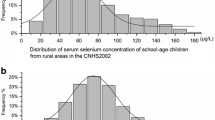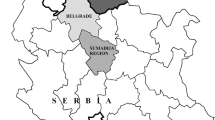Abstract
This study aimed at evaluation of a relationship between blood selenium concentration (Se-B) and blood cystatin C concentration (CST) in a randomly selected population of healthy children, environmentally exposed to lead and cadmium. The studies were conducted on 172 randomly selected children (7.98 ± 0.97 years). Among participants, the subgroups were distinguished, manifesting marginally low blood selenium concentration (Se-B 40–59 μg/l), suboptimal blood selenium concentration (Se-B: 60–79 μg/l) or optimal blood selenium concentration (Se-B ≥ 80 μg/l). At the subsequent stage, analogous subgroups of participants were selected separately in groups of children with BMI below median value (BMI <16.48 kg/m2) and in children with BMI ≥ median value (BMI ≥16.48 kg/m2). In all participants, values of Se-B and CST were estimated. In the entire group of examined children no significant differences in mean CST values were detected between groups distinguished on the base of normative Se-B values. Among children with BMI below 16.48 kg/m2, children with marginally low Se-B manifested significantly higher mean CST values, as compared to children with optimum Se-B (0.95 ± 0.07 vs. 0.82 ± 0.15 mg/l, p < 0.05). In summary, in a randomly selected population of healthy children no relationships could be detected between blood selenium concentration and blood cystatin C concentration. On the other hand, in children with low body mass index, a negative non-linear relationship was present between blood selenium concentration and blood cystatin C concentration.
Similar content being viewed by others
References
Burk RF, Hill KE (2009) Selenoprotein P-expression, functions, and roles in mammals. Biochim Biophys Acta 1790:1441–1447
Stone CA, Kawai K, Kupka R, Fawzi WW (2010) Role of selenium in HIV infection. Nutr Rev 68:671–681
Boitani C, Puglisi R (2008) Selenium, a key element in spermatogenesis and male fertility. Adv Exp Med Biol 636:65–73
Black RE (2001) Micronutrients in pregnancy. Br J Nutr 85:S193–S197
Micke O, Schomburg L, Buentzel J, Kisters K, Muecke R (2009) Selenium in oncology: from chemistry to clinics. Molecules 14:3975–3988
Navas-Acien A, Bleys J, Guallar E (2008) Selenium intake and cardiovascular risk: what is new? Curr Opin Lipidol 19:43–49
Köhrle J (2013) Selenium and the thyroid. Curr Opin Endocrinol Diabetes Obes 20:441–448
Lubos E, Sinning CR, Schnabel RB, Wild PS, Zeller T, Rupprecht HJ, Bickel C, Lackner KJ, Peetz D, Loscalzo J, Münzel T, Blankenberg S (2010) Serum selenium and prognosis in cardiovascular disease: results from the AtheroGene study. Atherosclerosis 209:271–277
Onopiuk A, Tokarzewicz A, Gorodkiewicz E (2015) Cystatin C: a kidney function biomarker. Adv Clin Chem 68:57–69
Odutayo A, Cherney D (2012) Cystatin C and acute changes in glomerular filtration rate. Clin Nephrol 78:64–75
Peralta CA, Whooley MA, Ix JH, Shlipak MG (2006) Kidney function and systolic blood pressure new insights from cystatin C: data from the Heart and Soul Study. Am J Hypertens 19:939–946
Shlipak MG, Katz R, Sarnak MJ, Fried LF, Newman AB, Stehman-Breen C, Seliger SL, Kestenbaum B, Psaty B, Tracy RP, Siscovick DS (2006) Cystatin C and prognosis for cardiovascular and kidney outcomes in elderly persons without chronic kidney disease. Ann Intern Med 145:237–246
Shlipak MG, Wassel Fyr CL, Chertow GM, Harris TB, Kritchevsky SB, Tylavsky FA, Satterfield S, Cummings SR, Newman AB, Fried LF (2006) Cystatin C and mortality risk in the elderly: the health, aging, and body composition study. J Am Soc Nephrol 17:254–261
Luo J, Wang LP, Hu HF, Zhang L, Li YL, Ai LM, Mu HY (2015) Cystatin C and cardiovascular or all-cause mortality risk in the general population: a meta-analysis. Clin Chim Acta 450:39–45
Angelidis C, Deftereos S, Giannopoulos G, Anatoliotakis N, Bouras G, Hatzis G, Panagopoulou V, Pyrgakis V, Cleman MW (2013) Cystatin C: an emerging biomarker in cardiovascular disease. Curr Top Med Chem 13:164–179
Weaver VM, Kim NS, Lee BK, Parsons PJ, Spector J, Fadrowski J, Jaar BG, Steuerwald AJ, Todd AC, Simon D, Schwartz BS (2011) Differences in urine cadmium associations with kidney outcomes based on serum creatinine and cystatin C. Environ Res 111:1236–1242
Poręba R, Gać P, Poręba M, Antonowicz-Juchniewicz J, Andrzejak R (2011) Relation between occupational exposure to lead, cadmium, arsenic and concentration of cystatin C. Toxicology 283:88–95
Skröder H, Hawkesworth S, Kippler M, El Arifeen S, Wagatsuma Y, Moore SE, Vahter M (2015) Kidney function and blood pressure in preschool-aged children exposed to cadmium and arsenic-potential alleviation by selenium. Environ Res 140:205–213
Agha FE, Youness ER, Selim MM, Ahmed HH (2014) Nephroprotective potential of selenium and taurine against mercuric chloride induced nephropathy in rats. Ren Fail 36:704–716
Ben Amara I, Karray A, Hakim A, Ben Ali Y, Troudi A, Soudani N, Boudawara T, Zeghal KM, Zeghal N (2013) Dimethoate induces kidney dysfunction, disrupts membrane-bound ATPases and confers cytotoxicity through DNA damage. Protective effects of vitamin E and selenium. Biol Trace Elem Res 156:230–242
Gać P, Pawlas N, Poręba R, Poręba M, Markiewicz-Górka I, Januszewska L, Olszowy Z, Pawlas K (2015) Interaction between blood selenium concentration and a levels of oxidative stress and antioxidative capacity in healthy children. Environ Toxicol Pharmacol 39:137–144
Pawlas N, Dobrakowski M, Kasperczyk A, Kozłowska A, Mikołajczyk A, Kasperczyk S (2016) The level of selenium and oxidative stress in workers chronically exposed to lead. Biol Trace Elem Res 170(1):1–8
Stępniewska J, Gołembiewska E, Dołęgowska B, Domański M, Ciechanowski K (2015) Oxidative stress and antioxidative enzyme activities in chronic kidney disease and different types of renal replacement therapy. Curr Protein Pept Sci 16:243–248
Rubattu S, Pagliaro B, Pierelli G, Santolamazza C, Castro SD, Mennuni S, Volpe M (2014) Pathogenesis of target organ damage in hypertension: role of mitochondrial oxidative stress. Int J Mol Sci 16(1):823–839
Acknowledgments
This work was supported by the European Union through its Sixth Framework Programme for RTD (contract no FOOD-CT-2006-016253). It reflects only the author’s views. The Community is not liable for any use that may be made of the information contained therein.
Author information
Authors and Affiliations
Corresponding author
Ethics declarations
Funding
This study was funded by the European Union through its Sixth Framework Programme for RTD (contract no FOOD-CT-2006-016,253).
Conflict of Interest
The authors declare that they have no conflict of interest.
Ethical Approval
All procedures performed in studies involving human participants were in accordance with the ethical standards of the institutional and/or national research committee and with the 1964 Helsinki Declaration and its later amendments or comparable ethical standards.
Informed Consent
Written informed consent was obtained from one parent or a caregiver and an oral consent from the child.
Rights and permissions
About this article
Cite this article
Gać, P., Pawlas, N., Wylężek, P. et al. Blood Selenium Concentration and Blood Cystatin C Concentration in a Randomly Selected Population of Healthy Children Environmentally Exposed to Lead and Cadmium. Biol Trace Elem Res 175, 33–41 (2017). https://doi.org/10.1007/s12011-016-0758-4
Received:
Accepted:
Published:
Issue Date:
DOI: https://doi.org/10.1007/s12011-016-0758-4




